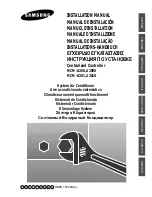
Maintenance
100
RT-SVX34F-EN
Coil Cleaning
Regular coil maintenance, including annual cleaning
enhances the unit’s operating efficiency by minimizing:
•
Compressor head pressure and amperage draw;
•
Water carryover;
•
Fan brake horsepower; and,
•
Static pressure losses.
At least once each year—or more often if the unit is located
in a “dirty” environment—clean the evaporator,
microchannel condenser, and reheat coils using the
instructions outlined below. Be sure to follow these
instructions as closely as possible to avoid damaging the
coils.
To clean refrigerant coils, use a soft brush and a sprayer.
Important:
DO NOT use any detergents with
microchannel condenser coils. Pressurized
water or air ONLY.
For evaporator and reheat coil cleaners, contact the local
Trane Parts Center for appropriate detergents.
1.
Remove enough panels from the unit to gain safe
access to coils.
a. For the 50 ton unit with the 3rd coil closest to the
bulk-head, safe access can be gained by removal of
the unit side panels.
b. For the 40 ton and 50 ton units, access to the 2-row
microchannel condenser coils removal of the
corner posts will be necessary.
Note:
Bridging between the main supports required
before attempting to enter into the unit. Bridging
may consist of multiple 2 by 12 boards or sheet
metal grating.
2. Straighten any bent coil fins with a fin comb.
3. For accessible areas, remove loose dirt and debris
from both sides of the coil. For dual row microchannel
condenser coil applications, seek pressure coil wand
extension through the local Trane Parts Center.
4. When cleaning evaporator and reheat coils, mix the
detergent with water according to the manufacturer’s
instructions. If desired, heat the solution to 150° F
maximum to improve its cleansing capability.
Important:
DO NOT use any detergents with
microchannel coils. Pressurized water or air
ONLY.
5. Pour the cleaning solution into the sprayer. If a high-
pressure sprayer is used:
a. The minimum nozzle spray angle is 15 degrees.
b. Do not allow sprayer pressure to exceed 600 psi.
c. Spray the solution perpendicular (at 90 degrees) to
the coil face.
d. For evaporator and reheat coils, maintain a
minimum clearance of 6" between the sprayer
nozzle and the coil. For microchannel condenser
coils, optimum clearance between the sprayer
nozzle and the microchannel coil is 1"-3”.
6. Spray the leaving-airflow side of the coil first; then
spray the opposite side of the coil. For evaporator and
reheat coils, allow the cleaning solution to stand on the
coil for five minutes.
7.
Rinse both sides of the coil with cool, clean water.
8. Inspect both sides of the coil; if it still appears to be
dirty, repeat Steps 6 and 7.
9. Reinstall all of the components and panels removed in
Step 1; then restore power to the unit.
10. For evaporator and reheat coils, use a fin comb to
straighten any coil fins which were inadvertently bent
during the cleaning process.
Microchannel Condenser Coil Repair and
Replacement
If microchannel condenser coil repair or replacement is
required, seek HVAC Knowledge Center information or
General Service Bulletin RT-SVB83*-EN for further details.
Fall Restraint
The fall restraint is located approximately 3 feet from the
unit edge. See
Figure 62, p. 101
WARNING
No Step Surface!
Do not walk on the sheet metal drain pan. Walking on
the drain pan could cause the supporting metal to
collapse, resulting in the operator/technician to fall.
Failure to follow this recommendation could result in
death or serious injury.
WARNING
Falling Off Equipment!
This unit is built with fall restraint slots located on unit
top that MUST be used during servicing. These slots are
to be used with fall restraint equipment that will not
allow an individual to reach the unit edge. However
such equipment will NOT prevent falling to the ground,
for they are NOT designed to withstand the force of a
falling individual. Failure to use fall restraint slots and
equipment could result in individual falling off the unit
which could result in death or serious injury.
















































